|
Cleopatra's Needle (London)
|
| Present Site: | Victoria Embankment, London, England N 51°30'30.5"(51.508471) E 0°07'13.2"(-0.120335) |
| Pharaoh: | Tuthmosis III (New Kingdom 18th Dynasty, Reigned 15 Century BC) |
| Measurement: | 20.88 meters high |
| Weight: | Estimated 187 tons |
| Stone: | Red granite |
About The Site:
The obelisk stands at the bank of Themes River called "Victoria Embankment". It is about 1 km down from the famous Big Ben (or Elizabeth Tower), on the left bank.
"Victoria Embankment" is not only for the site of obelisk, is the wide area from north of the Parliament Building to Temple Station (underground), which is about 2 km long.
However, most people may image around the obelisk because here is a Victoria Embankment Park and the Victoria Embankment Pier of River Tour Boat.
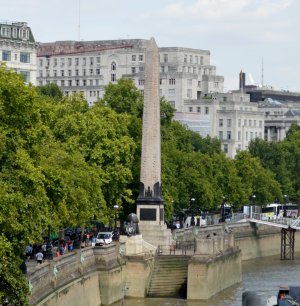 Looking from the Golden Jubilee Bridge Looking from the Golden Jubilee BridgeIt stands on the jetty site of the bank |
How To Get There:
The Embankment Station (Underground; Circle Line, District Line, Bakerloo Line, Northern Line) would be the most convenient. Get out at the river side, and walk about 300 meters, although it's slightly difficult to find the obelisk due to the street trees, but you can find it if you look for it along the Thames. Cross the road, then you can closely look the tall obelisk which is flanked by two bronze Sphinxes. You must feel a deep emotion when you consider that it was carried out from far away Egypt.
Please do not enter into the Victoria Embankment Park which is next to the underground station. The obelisk is not in the park.
When I visited there in August 2014, the platform of Bakerloo and Northern Lines was closed and trains did not stop due to the improvement works. The works will be finished in November 2014.
About The Obelisk:
This obelisk has a long history, which was initially erected in Heliopolis in 15 Century BC, and was transported to the town of Alexandria in 1 Century BC, and was toppled in 14 Century by the heavy earthquake, and then finally transported to London. The detailed story is ab below:
Tuthmosis III in New Kingdom era (reigned 1504-1450 BC) erected a pair of obelisk for dedicating the Temple of the Sun in Heliopolis. The record at that time says; the officer named Yamu-Nedjeh managed the building, and dedicated for the 3rd Jubilee of Tuthmosis III.
In around 10 BC, the first Roman Emperor Augustus had carried 2 obelisks from Heliopolis to Alexandria for decorating the front of the Caesarium Temple which enshrines the Julius Caesar.
Then one (of two obelisks) was toppled due to the large earthquake in 1303, but it was never re-erected.
The British first began to consider appropriating this obelisk when General Cavan [1763-1836, 7th Earl of Cavan, Richard Ford William Lambart] had an idea to get this in commemoration of the victories of the Battle of Aboukir of 1801.
Egyptian viceroy, Mohammed Ali approved in 1819 that Egypt would make a gift obelisk to Britain. In 1831 the approval was renewed, but the British Government declined to fund the expense of transportation to London.
Finally in the 1870s, the soldier-turned-writer General James Alexander of Britain took up the cause, and then he did serious efforts for this collection with the support by a millionaire Sir James Erasmus Wilson who offered the private fund voluntarily. After a time-consuming negotiation with the land owner of the obelisk, it was planned that the obelisk is transported over the ocean with a special iron container (cylindrical case) named Cleopatra made by the engineer, John Dixson. At last, Cleopatra which contains the obelisk departed the Port of Alexandria, towed by the mother ship Olga, on September 21st, 1877. It has passed almost 80 year since the Battle of Aboukir.
While Britain spent a long time, France has obtained another obelisk (where was in Luxor), and successfully transported it to Paris in 1832. It stands at the Place de la Concorde at present. See here for the detailed story.
The Olga and the Cleopatra which headed to London via Atlantic Ocean passing through the Straits of Gibraltar, came across the storm in the Bay of Biscay (Golfe de Gascogne in French) on October 14, and a gale separated the two ships and six seamen were lost. The Glasgow steam ship Fitzmaurice discovered the drifted Cleopatra, and towed it into the port of El Ferrol, a small town in Northwestern Spain. The ship owner claimed the possession, and required a buy-back of the obelisk which was almost lost at ocean.
On January 15th, 1878, the Cleopatra finally departed the Spanish port, with pulled up by the steam ship Anglia this time, and ended the long travel when arrived at Gravesend, a mouth of the Thames, on January 21st, 1878. It has elapsed 4 months from Egypt and England, and another almost 80 years. Then it went up the Thames and moored near the Houses of Parliament.
Eight months later, on September 12th (13th?), 1878, the obelisk was raised on the pedestal at the river front of the Thames. The obelisk is supported by the iron ornament because it cannot stand by itself due to the missing the foot of monolith. The pedestal enclosed various memorial objects like copies of contemporary newspapers and a full set of British Empire coins.
Just for your reference, its companion [which didn't fall by the 1303 earthquake] was also transported to New York in 1880, 3 years later of London obelisk.
Therefore, there is no obelisk in Alexandria at present.
About The Nickname: This obelisk is called as the nickname of "Cleopatra's Needle". Other obelisks in New York and Paris are also called "Cleopatra's Needle" as well. However, those obelisks have no relations to the famous Queen Cleopatra (Cleopatra VII, 69 - 39 BC). Thus the nickname would be inappropriate, but we use this name for the title of our website here because it's widely known globally.
Current Status and Inscriptions: Not only by the lack of funding, the poor status of preservation was one of reasons of delayed transportation to London. The corners of obelisk are rounded and the faces got rough with weathering. This may be due to the cold weather in England.
The inscriptions can be hardly read as it's deeply inscribed. On each side of the obelisk is inscribed with hieroglyph of three columns. The central column is carved by Tuthmosis III, and subsidiary columns both sides are added by Ramses II about 250 years later. The central inscriptions include the name of Horus, at enthronement, and at birth of Tuthmosis III. The name of Horus are described with different style.
On each side of each pyramidion (top triangle of the obelisk), Tuthmosis III is drawn as a "sphinx" making offerings to the Gods of Heliopolis.
The obelisk is supported by two bronze Sphinxes. The pedestal and the Sphinx were a little damaged by the German bombs in 1917, during World War I, and the gouges still can be seen.
The height or length of this obelisk varies depend upon the sources: 20.88 meters (*1), 20.87 meters (*2), and 68 feet [= 20.73 meter]. The weight also varies: 180 tons (*3), and 187 tons (*2).
(*1) The Complete Temples of Ancient Egypt, Richard H. Wilkinson.
(*2) The Obelisks of Egypt, Labib Habachi.
(*3) Cleopatra's Needles and Other Egyptian Obelisks, E.A. Eallis Budge.
Notes For Pictures:
It was not easy to take a picture of this obelisk because it's surrounded by trees and the obelisk stands at the river side. When taking the west side, the trees block the obelisk. For the south side and north side, I took it from the pier of river boat. For the east side, I took it from the opposite side of Thames with telescope lens of 200mm across the river through Golden Jubilee Bridge.
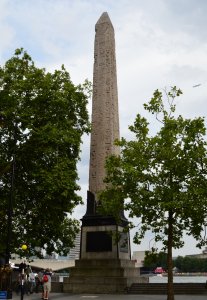 West Side |
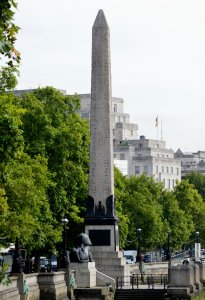 South Side |
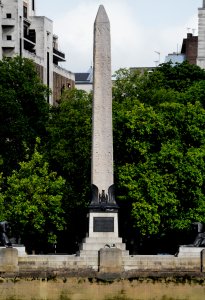 East Side |
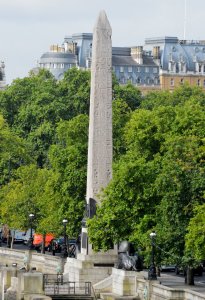 North Side |
|||
August 1, 2014 by Hiroyuki Nagase (For high definition image, please click the picture) | ||||||
Copyright Hiroyuki Nagase nagase@obelisks.org and Shoji Okamoto okamoto@obelisks.org